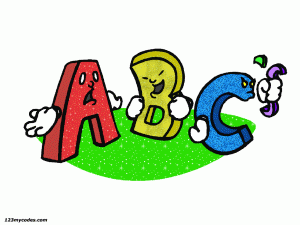
Credit: http://www.123backgrounds.com/
A is for audition. Get used to it. You’ll have to. And accompaniment. That’s what you are—not the soloist!
B is for Body odor. None appreciated— even the most expensive perfume. Onstage it’s a no-no.
C is for Cough drops. If you have a cough have a pocketful— unwrapped of course.
D is for Decisions. They are not yours to make! The conductor is in charge whether you agree or not.
E is for Excuse. There are none. You either cut it or you don’t!
F is for Flat. Don’t be. If your tendency is to play too low play higher. If your interpretation is likewise—flat, liven it up.
G is for Giggling, grunting, groaning and gasping, and any other extraneous outbursts of noise or editorial comments. Suppress them!
H is for Histrionics. None tolerated.
I is for Invention. It is a short contrapuntal piece not an invitation to make up notes.
J is for jig. The jig is up if you’re jealous of colleagues earning more than you do or playing more solos than you do. It’s difficult to make music when you feel that way.
K is for Kettledrum, Keyboard, Klavier, and Kontrbass, common instruments in an ensemble. But not kazoo. Sorry about that!
L is for legato. No matter how nervous you are, even if your bow is shaking, you have to play smoothly.
M is for Metronome. It’s a necessary evil. Practice with it often. You’ll be surprised how it never lies! Sometimes you’ll find that indeed you are unsteady in your rhythm— perhaps slowing in panic where it is more difficult and sometimes speeding up when it is easier.
N is for Notice. The conductor may be slowing down or speeding up or stopping suddenly in rehearsal. (sigh)But you too must stop instantly to listen to his or her instructions.
O is for optional. Nothing is in an orchestra. No arguments. You do what you are asked to do. It is the conductor’s interpretation not yours.
P is for Practicing. Consistent practicing—No ifs, ands or buts.
Q is for Questions. Too many questions stop the rehearsal. Questions during the rehearsal open the door for the conductor to wax eloquent about the piece or the composer. Do you want it faster or slower, louder or softer, shorter or longer? That’s plenty!
R is for Rehearsals. Rehearsing is important. Be there unless you have leprosy.
S is for Sit. Stay in your seat at all times. And Singing. Do not. Even if the conductor does!
T is for tardy. Never be Tardy. Once there’s a downbeat it’s to late to waltz onto the onstage during a performance. And when it says Tacet. Don’t play whatever you do! It means silent.
U is for unfazed. No matter what happens onstage do not react. Learn that orchestral poker face. The audience doesn’t need to know who came in wrong or if the conductor missed a beat.
V is for Violin. Despite the fact that they are oftentimes the prima donnas of the orchestra, the violins get the melody most of the time and you should follow them.
W is for woodwinds. Humor them. They are all by themselves on their parts and their instruments are finicky with those pesky reeds. Follow them too.
X is for X-tra. No extra slides, extra length on notes, extra loud playing that sticks out, or extra embellishments. Save that for your recitals and solo playing.
Y is for yawning. It’s part of the learning curve to discover how to yawn with your mouth closed for heaven’s sake!
Z is for Zurückhalten. Hold back. Your ensemble is not “adult day-care.” Hold back from making opinionated comments, from meddlesome interruptions and from messing around. Jokesters are fun but at intermission!



